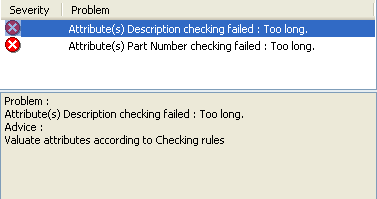Attributes Valuation Finalization Check (PLMAttributesValuationFinalization) | ||
| ||
General Information
This opening ID is called in the PLM New, Edit Properties and Sheet Editor dialogs when the user commits the attribute valuation (action behind the Apply, Finish or OK buttons).
The table below provides you with information related to the definition of the Opening ID.
| Opening ID: | PLMIAttributesValuationFinalization |
| Customization intent: | Validation |
| Execution context: | Client |
Input Objects
Input objects must be of the following types:
ThisObjectParameterscorresponds to the context object.Validation
Context Object Parameters
| Parameter Names | Types | Read/Write | Comments |
|---|---|---|---|
| ErrorAttributes | List of Strings | Write | Output parameter which contains the list of the attribute identifiers which valuation lead to raise a user error. |
| ErrorMessages | List of Strings | Write | Output parameter which contains the list of the NLS error message corresponding to each ErrorAttribute. |
| Policy | String | Read | Policy name. |
| Important: These lists are accessed in rules with GetAttributeObject API on the context. They must be set on the context with SetAttributeObject at the end of the rule ( see sample ) unless they won't be applied. |
Sample
The following sample show how to check that the length of the V_description attribute + the length of the PLM_ExternalID attribute is less than 80 characters.
The resulting UI message will be the following one:
This family references the script that contains the business logic implementation, which looks like the following CATRule file: 
This family references the script that contains the business logic implementation, which looks like the following CATRule file:
<Scripts>
<Script OpeningID="PLMAttributesValuationFinalization"
Type="MyPLMProduct"
ScriptName="MyProductAttrFinalyzeScript" />
</Scripts>
Let Errorlist(List)
Let ErrorMessagelist(List)
Let PublishedMessage(String)
Let Error(string)
Let Description(string)
Let Id(string)
Let L=0
Validation=true
set Errorlist = Parameters->GetAttributeObject("ErrorAttributes")
set ErrorMessagelist = Parameters->GetAttributeObject("ErrorMessages")
Description=ThisObject.V_description
Id=ThisObject.PLM_ExternalID
L=Description->Length()+Id->Length()
if (L>80)
{
Validation=false
ErrorMessagelist->Append("Too long.")
Errorlist->Append("V_description")
ErrorMessagelist->Append("Too long.")
Errorlist->Append("PLM_ExternalID")
}
if (Validation == false)
{
Parameters->SetAttributeObject("ErrorMessages",ErrorMessagelist)
Parameters->SetAttributeObject("ErrorAttributes",Errorlist)
}